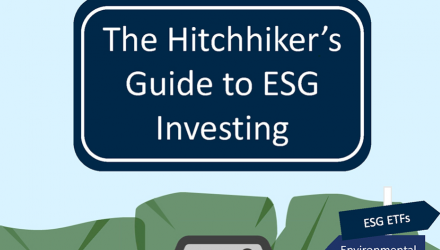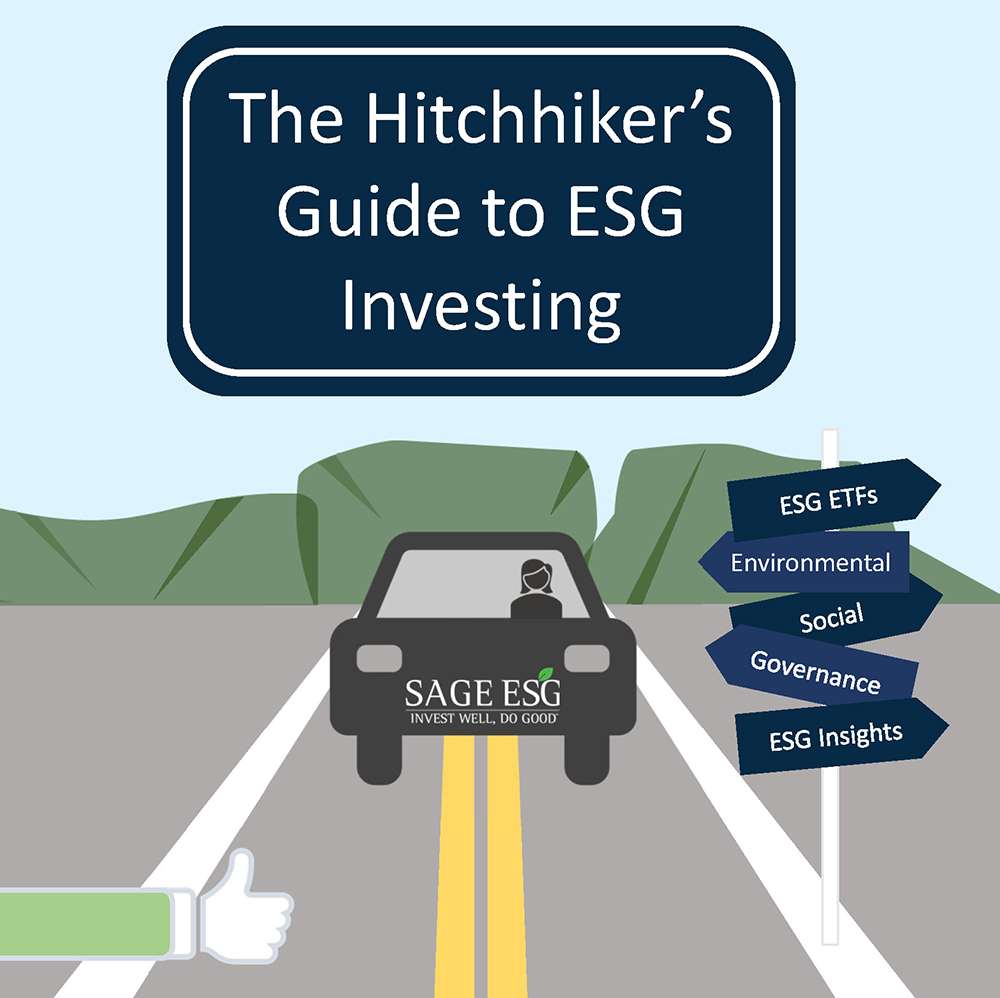This podcast is part of Sage’s series The Hitchhiker’s Guide to ESG Investing.
In this episode, Sage’s Komson Silapachai and Emma Smith discuss the three trends that are creating the ideal conditions for environmental, social, and governance (ESG) investing to see enormous growth – a solid track record of performance during various market environments, improvement in the breadth of ESG investments, and the rise in demand for values-based investing.
Click here to listen to the podcast:
Here is the full transcript – Total time: 9:34
0:00
Komson Silapachai: Well welcome to the first episode of The Hitchhiker’s Guide to ESG Investing. My name is Komson Silapachai, vice president of research and portfolio strategy here at Sage. I focus on ESG as well as macro strategy. I’m here with Emma Smith. So Emma, do you want to introduce yourself?
Emma Harper: So I’m Emma Smith, I am an ESG research analyst, and I spend my days researching companies, researching ETFs, and basically, all on the ESG side of things.
Komson Silapachai: Yeah, it’s crazy. I mean, just the amount of traction that ESG has been receiving, just in the last 12 months, at least in ETF land, has been a perfect storm for ESG. And there’s been three major trends that we think have contributed to it. First, you’ve seen enough of a track record for investors. I mean, you just look at the last three years, you know, fourth quarter of 2018, negative 20% drawdown in equities, one of the best years for equity markets in 2019. And, you know, I’m talking all risk assets. Corporate bonds did super well in 2019 as well. And then obviously, in 2020, we had, you know, just halfway through, we’ve had more events than we could count, namely the COVID crisis and the shutdown, a 35% drawdown in equities then a recovery to the tune of 40-plus percent. So, you’ve had enough events to judge an ESG strategy over that time period.
1:33
Emma Harper: Absolutely. And same on the fixed income side. I mean, over, you know, the crisis we’ve seen, we saw that ESG fixed income strategies outperformed their conventional counterparts by a significant amount. And it really, really showed the proof is in the pudding. That there is a significant amount of downside protection, a significant amount of risk protection, which is what you’re looking for in fixed income. You’re a risk manager, you’re looking to protect your downside. Most often you’re looking for more that sleep-well money. And so it really did provide that kind of cushion to the wild ride that we saw a quarter one.
2:13
Komson Silapachai: Right, within the second big trend after a sufficient amount of performance within ESG strategies is the fact that you get now you have a breadth of strategies that an investor can choose from. When ETFs launched in ESG in the mid-2000s, it was really only U.S. equities. Now, you can do international equities, you can go emerging market. Within the fixed income side, there’s corporate bonds, there’s green bonds,
Emma Harper: So much more of a selection.
Komson Silapachai: Oh, totally. And I think we’re starting to see things like emerging market debt and high yield.
2:47
Emma Harper: Right, yeah. So agreed that the amount of selection in terms of fixed income ETFs, you know, alone is vastly different than three years ago, and I really think that it came about with a better tool kit that we have to be able to look into how the issuers are actually performing, like as far as the ESG perspective. I mean, we’ve been doing this for a very long time, but I would say over the last several years, the data and disclosure has become so much more easy to access. And we’re able to see into, you know, private companies as well as public companies, which really was a problem in the past. And it’s opening up now because I think issuers, companies that are looking at trends, they’re looking at demand overall. And they’re seeing that consumers of their debt or their equity are wanting to see this different side of them, see the ESG side of them. They want to have more disclosure, you can see it from all kinds of shareholder proposals that are out there.
3:50
Komson Silapachai: Yeah, I think you’re exactly right. I mean, I think when I think about the third trend, you know, just to kind of segue is that now, investors are more value-focused than ever before. And, you know, it’s not just investors, you look society wide, the way that consumers are consuming, whether it’s clothes, really any product and service the brand value is really dependent on the kind of values of the company, oftentimes, and I think it’s no different in ESG. But, you know, you couple that with, you know, like, like I said, the performance, and also kind of the breadth of strategies that you now have access to. We call it a perfect storm.
4:39
It took ETF so the first ETF was launched in 2006. It took about five years, or actually two years to go from zero to $1 billion in assets. So, you know, two years go to $1 billion. To go from one to $5 billion, it took 12 years. And then 18 months later, we’re here $25 billion. So the growth has been literally parabolic right. However, ESG equity assets only represent less than a percent, so 0.8% of total equity ETF assets. So just to kind of put it in perspective, still a tremendous amount of growth. You know, as of April 30, ESG equity ETFs represented 30% of the flow into equity ETFs, so that’s huge. I mean, I just think that that number is striking. And in fixed income, not as robust, but we think –
5:38
Emma Harper: No, I was going to say, smaller part, a little bit of a smaller part of the pie there in fixed income, but I still see growth. And even over the last couple of years I’ve seen the growth and just the amount of fixed income options that we personally have to invest in. So just see it continuing, it might be a little bit behind its equity counterpart, but I think definitely going to see it continuing and growing.
6:01
Komson Silapachai: Yeah, no, and I totally agree. You look at the AUM of ESG fixed income, only 0.1% of AUM for ESG ETFs in fixed income, you know, tremendous growth opportunities. So I think that, you know, as you see flows into this space, and more product launches, more strategy launches, this number will grow. So, something super interesting and I think that’s going to permeate really into a lot of different areas as well. I mean, it started with institutions, you’re starting to see it flowing into private wealth, retail sector, in terms of investors. And then I think you’ll start to see it go across different types of investment systems, such as defined contributions, so 401(k) plans.
6:52
Emma Harper: And I think that kind of blends into what you were talking about the change in values-based investing becoming more important, I think, something that we’ve taken a look at, I mean, you and I personally have taken a look at, Sage has taken a look at, is basically the shift in, you know, wealth transfer to, to the millennial group. That’s happening and, and I also think the millennial group, obviously utilizes defined contribution plans greatly as part of their retirement plan, retirement savings plan. And so having more options in the 401(k)s, in the defined contribution plans, only serve the millennial group that utilizes them so strongly, even better. I mean, I think if you put more options in there, you would see a great uptick in investment in ESG ETFs.
7:45
Komson Silapachai: Definitely. And so let me wrap up. Like I said, three factors and three trends contributing to the growth of ESG assets in ETFs. First, you have enough performance, of a track record of a lot of these ETFs across a lot of different market environments – fourth quarter of ‘18 drawdown, a bull market in 2019. And obviously, what’s going on this year during the COVID crisis. The second one is the improvement and an increase of breadth of opportunities and selection within ESG strategies in ETF land. And then third, the rise in values-based investing. To keep up with us, check us out on our LinkedIn page Sage Advisory or Instagram @sageadvisory, and we look forward to having you tune in future episodes. Thanks!
Disclosures: Sage Advisory Services is a registered investment adviser that provides investment management services for a variety of institutions and high net worth individuals. This podcast is for informational purposes only and is not intended as investment advice or an offer or solicitation with respect to the purchase or sale of any security, strategy or investment product. Investors should make their own decisions on investment strategies based on their specific investment objectives and financial circumstances. All investments contain risk and may lose value. Past performance is not a guarantee of future results.
For additional information on Sage and its investment management services, please view our web site at WWW.SAGEADVISORY.COM, or refer to our Form ADV, which is available upon request by calling 512.327.5530.


